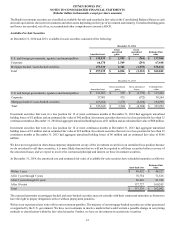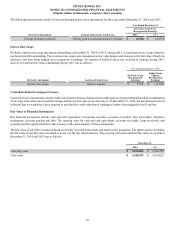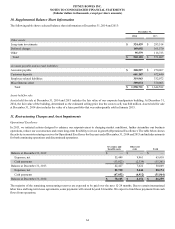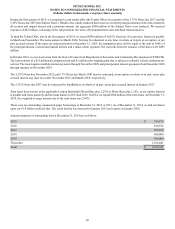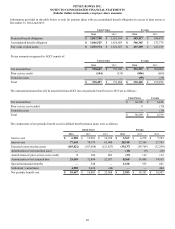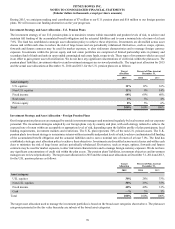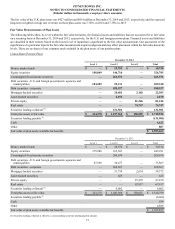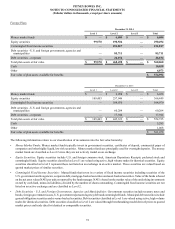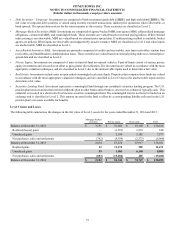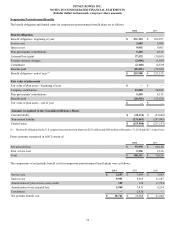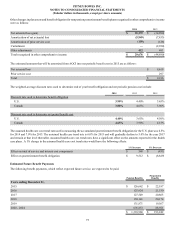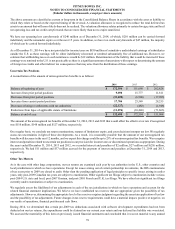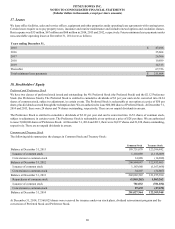Pitney Bowes 2014 Annual Report Download - page 80
Download and view the complete annual report
Please find page 80 of the 2014 Pitney Bowes annual report below. You can navigate through the pages in the report by either clicking on the pages listed below, or by using the keyword search tool below to find specific information within the annual report.
PITNEY BOWES INC.
NOTES TO CONSOLIDATED FINANCIAL STATEMENTS
(Tabular dollars in thousands, except per share amounts)
70
During 2015, we anticipate making total contributions of $7 million to our U.S. pension plans and $16 million to our foreign pension
plans. We will reassess our funding alternatives as the year progresses.
Investment Strategy and Asset Allocation - U.S. Pension Plans
The investment strategy of our U.S. pension plans is to maximize returns within reasonable and prudent levels of risk, to achieve and
maintain full funding of the accumulated benefit obligation and the actuarial liabilities and to earn a nominal rate of return of at least
7.0%. The fund has established a strategic asset allocation policy to achieve these objectives. Investments are diversified across asset
classes and within each class to reduce the risk of large losses and are periodically rebalanced. Derivatives, such as swaps, options,
forwards and futures contracts may be used for market exposure, to alter risk/return characteristics and to manage foreign currency
exposure. Investments within the private equity and real estate portfolios are comprised of limited partnership units in primary and
secondary fund of funds and units in open-ended commingled real estate funds, respectively. These types of investment vehicles are used
in an effort to gain greater asset diversification. We do not have any significant concentrations of credit risk within the plan assets. The
pension plans' liabilities, investment objectives and investment managers are reviewed periodically. The target asset allocation for 2015
and the actual asset allocations at December 31, 2014 and 2013, for the U.S. pension plans are as follows:
Target
allocation
Percent of Plan Assets at
December 31,
2015 2014 2013
Asset category
U.S. equities 11% 12% 16%
Non-U.S. equities 11% 9% 14%
Fixed income 68% 69% 60%
Real estate 2% 5% 4%
Private equity 8% 5% 6%
Total 100% 100% 100%
Investment Strategy and Asset Allocation - Foreign Pension Plans
Our foreign pension plan assets are managed by outside investment managers and monitored regularly by local trustees and our corporate
personnel. The investment strategies adopted by our foreign plans vary by country and plan, with each strategy tailored to achieve the
expected rate of return within an acceptable or appropriate level of risk, depending upon the liability profile of plan participants, local
funding requirements, investment markets and restrictions. The U.K. plan represents 74% of the non-U.S. pension assets. The U.K.
pension plan's investment strategy is to maximize returns within reasonable and prudent levels of risk, to achieve and maintain full funding
of the accumulated benefit obligation and the actuarial liabilities and to earn a nominal rate of return of at least 7.0%. The fund has
established a strategic asset allocation policy to achieve these objectives. Investments are diversified across asset classes and within each
class to minimize the risk of large losses and are periodically rebalanced. Derivatives, such as swaps, options, forwards and futures
contracts may be used for market exposure, to alter risk/return characteristics and to manage foreign currency exposure. We do not have
any significant concentrations of credit risk within the plan assets. The pension plans' liabilities, investment objectives and investment
managers are reviewed periodically. The target asset allocation for 2015 and the actual asset allocations at December 31, 2014 and 2013,
for the U.K. pension plan are as follows:
Target
Allocation
Percent of Plan Assets at
December 31,
2015 2014 2013
Asset category
U.K. equities 30% 28% 33%
Non-U.K. equities 30% 29% 35%
Fixed income 40% 40% 31%
Cash —% 3% 1%
Total 100% 100% 100%
The target asset allocation used to manage the investment portfolios is based on the broad asset categories shown above. The plan asset
categories presented in the fair value hierarchy are subsets of the broad asset categories.



